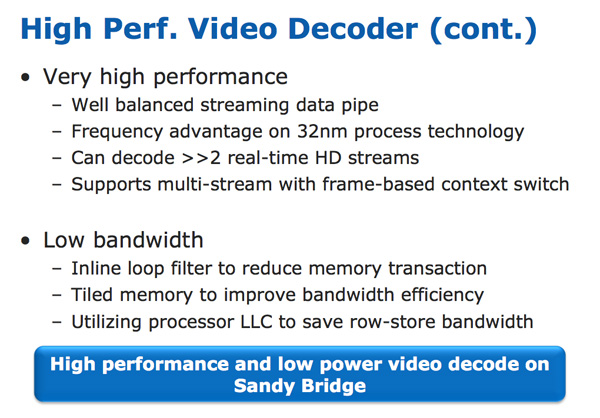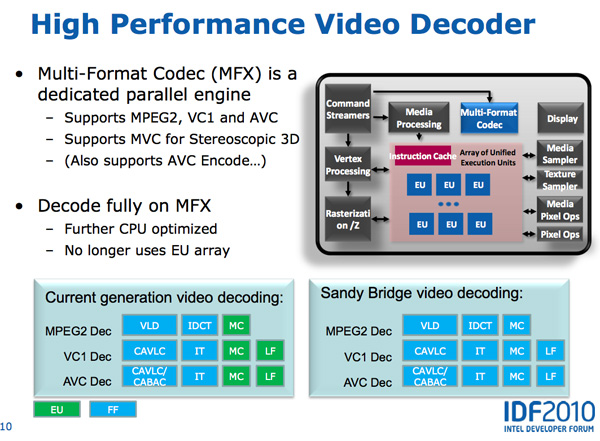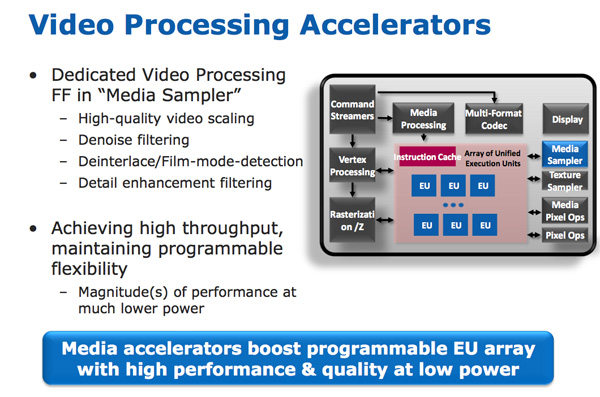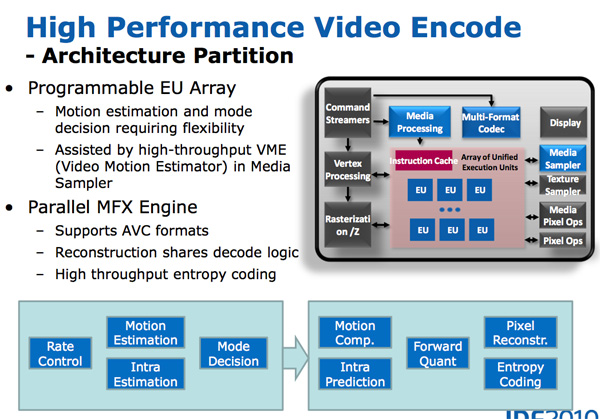The Sandy Bridge Review: Intel Core i7-2600K, i5-2500K and Core i3-2100 Tested
by Anand Lal Shimpi on January 3, 2011 12:01 AM ESTIntel’s Quick Sync Technology
In recent years video transcoding has become one of the most widespread consumers of CPU power. The popularity of YouTube alone has turned nearly everyone with a webcam into a producer, and every PC into a video editing station. The mobile revolution hasn’t slowed things down either. No smartphone can play full bitrate/resolution 1080p content from a Blu-ray disc, so if you want to carry your best quality movies and TV shows with you, you’ll have to transcode to a more compressed format. The same goes for the new wave of tablets.
At a high level, video transcoding involves taking a compressed video stream and further compressing it to better match the storage and decoding abilities of a target device. The reason this is transcoding and not encoding is because the source format is almost always already encoded in some sort of a compressed format. The most common, these days, being H.264/AVC.
Transcoding is a particularly CPU intensive task because of the three dimensional nature of the compression. Each individual frame within a video can be compressed; however, since sequential frames of video typically have many of the same elements, video compression algorithms look at data that’s repeated temporally as well as spatially.
I remember sitting in a hotel room in Times Square while Godfrey Cheng and Matthew Witheiler of ATI explained to me the challenges of decoding HD-DVD and Blu-ray content. ATI was about to unveil hardware acceleration for some of the stages of the H.264 decoding pipeline. Full hardware decode acceleration wouldn’t come for another year at that point.
The advent of fixed function video decode in modern GPUs is important because it helped enable GPU accelerated transcoding. The first step of the video transcode process is to first decode the source video. Since transcoding involves taking a video already in a compressed format and encoding it in a new format, hardware accelerated video decode is key. How fast a decode engine is has a tremendous impact on how fast a hardware accelerated video encode can run. This is true for two reasons.
First, unlike in a playback scenario where you only need to decode faster than the frame rate of the video, when transcoding the video decode engine can run as fast as possible. The faster frames can be decoded, the faster they can be fed to the transcode engine. The second and less obvious point is that some of the hardware you need to accelerate video encoding is already present in a video decode engine (e.g. iDCT/DCT hardware).
With video transcoding as a feature of Sandy Bridge’s GPU, Intel beefed up the video decode engine from what it had in Clarkdale. In the first generation Core series processors, video decode acceleration was split between fixed function decode hardware and the GPU’s EU array. With Sandy Bridge and the second generation Core CPUs, video decoding is done entirely in fixed function hardware. This is not ideal from a flexibility standpoint (e.g. newer video codecs can’t be fully hardware accelerated on existing hardware), but it is the most efficient method to build a video decoder from a power and performance standpoint. Both AMD and NVIDIA have fixed function video decode hardware in their GPUs now; neither rely on the shader cores to accelerate video decode.
The resulting hardware is both performance and power efficient. To test the performance of the decode engine I launched multiple instances of a 15Mbps 1080p high profile H.264 video running at 23.976 fps. I kept launching instances of the video until the system could no longer maintain full frame rate in all of the simultaneous streams. The graph below shows the maximum number of streams I could run in parallel:
| Intel Core i5-2500K | NVIDIA GeForce GTX 460 | AMD Radeon HD 6870 | |
| Number of Parallel 1080p HP Streams | 5 streams | 3 streams | 1 stream |
AMD’s Radeon HD 6000 series GPUs can only manage a single high profile, 1080p H.264 stream, which is perfectly sufficient for video playback. NVIDIA’s GeForce GTX 460 does much better; it could handle three simultaneous streams. Sandy Bridge however takes the cake as a single Core i5-2500K can decode five streams in tandem.

The Sandy Bridge decoder is likely helped by the very large (and high bandwidth) L3 cache connected to it. This is the first advantage Intel has in what it calls its Quick Sync technology: a very fast decode engine.
The decode engine is also reused during the actual encode phase. Once frames of the source video are decoded, they are actually fed to the programmable EU array to be split apart and prepared for transcoding. The data in each frame is transformed from the spatial domain (location of each pixel) to the frequency domain (how often pixels of a certain color appear); this is done by the use of a discrete cosine transform. You may remember that inverse discrete cosine transform hardware is necessary to decode video; well, that same hardware is useful in the domain transform needed when transcoding.
Motion search, the most compute intensive part of the transcode process, is done in the EU array. It's the combination of the fast decoder, the EU array, and fixed function hardware that make up Intel's Quick Sync engine.













283 Comments
View All Comments
dansus - Saturday, February 19, 2011 - link
Looking at the results of Quick Sync transcoding, the results are very interesting.But which h264 encoder is ArcSoft using, im guessing its Mainconcept, would like to compare QS with x264 to be sure of the results.
In future, be nice to see the original frame to compare with too. Without the original, comparing just the encoded frames means little.
7eventh - Sunday, February 20, 2011 - link
Looking at cbscores.com (using the actual Cinebench 11.5) the 2600K is not THAT glorious at rendring-speed ... Why did you use Cinebench 10?pshen7 - Tuesday, February 22, 2011 - link
Who in the world named it Sandy Bridge? And Cougar Point is no better. They need a better marketing department. Seriously.Peter Shen, Koowie.com
zzzxtreme - Thursday, March 3, 2011 - link
does that mean I can't install windows XP/DOS on UEFI motherboards?dwade123 - Tuesday, March 8, 2011 - link
Intel i3 2100 is so underrated. It beats AMD's fastest's 6 core and older i7 Quadcores in many games and is only a little slower in other areas.Wouggie - Tuesday, March 15, 2011 - link
With an even improved i7990 Extreme now out, with a base speed of 3.46 GHz, which would be the better choice, considering I am going to using a dedicated graphics card Nvidia Quadro 4000.Also. what do you see on the horizon for three channel motherboards with more than 2 SATA lll 6 Gb/s connectors?
georgevt - Sunday, March 27, 2011 - link
The benchmarks against the AMD processors are useless. All the compare is core-to-core performance (4 core to 4 core). You should be comparing is comparably priced processors/systems. For example, the 6-core AMD 1090T costs a hundred dollars less than the i7 2600 at newegg.com, yet your benchmarks fail to provide any comparative benchmarks. It's quite possible that for some applications, that the 6-core AMD may perform better than the more expensive i4-core 7 processors in your benchmarks.scurrier - Friday, April 1, 2011 - link
Anand says, "frequency domain (how often pixels of a certain color appear)," but this definition of the frequency domain is incorrect. Frequency domain in the case of video is a 2 dimensional discrete cosine transform of the frame. It is not a count of pixels like a histogram (binning) or anything.aka_Warlock - Saturday, April 30, 2011 - link
Would be nice to see som test of how much of a performance difference lacking VT-d has on th CPU?AbdurRauf - Monday, May 2, 2011 - link
Does the QuickSync handle uprezing or only transcoding? Have you looked at the new WinFast HPVC1111 SpursEnginex4 and compared it to Quicksync, Cuda and Stream encoding and uprezing?